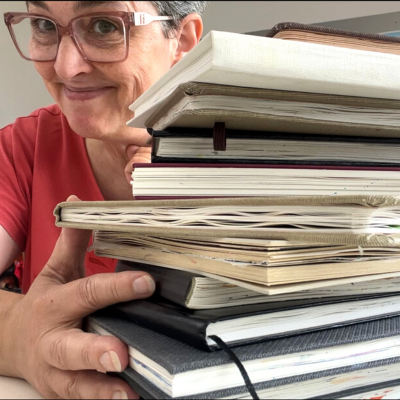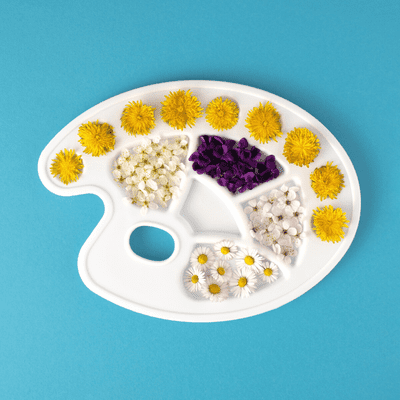What it takes to become a full-time artist
People are always asking me: how did you become an artist? What did you do? Did you go to art school? How do you live with it, etc.? So it’s interesting that I can ask other people how they did that.
Charlotte Hamilton is the first artist in this series to explain what it takes to become a full-time artist.

What is being an artist for you?
Being an artist is encompassing your life with beautiful things, expressing yourself through color, and doing what you love. As an artist, I’ve never swayed away from what I do. Sometimes it’s a struggle because you have not necessarily had to advertise yourself, but if you’re a freelancer, you have to.
You have to be ready to accept anything that comes your way. And sometimes it’s tough. So I think you have to be strong and persistent. When you start thinking, should I just get a regular job? And many people have a regular job, like a daytime job. And then I say, no, I can find something I can do creatively. Something in the realm of being an artist that will make me happy every day.
Consistency and persistence in doing something that you love always doing.

Have you always been doing art?
I always chose anything to do with art, graphic drawing, or design in school. After doing A levels in England, I attended a foundation course where you select three or four main subjects.
I then went to St. Martin art school in London and did a foundation course where you touch everything, and it’s to prepare you for a degree. And then my mom said: Why don’t you go to Spain, we have a connection, and he runs an art school over there, and it seems like what you want to do.
And so when I was 19, I left England and moved to Spain, and I was there for seven years. I only went to the art school for eight months, but it was the best teaching I had ever gotten. It was so structured, and something clicked. And I could see things a lot clearer. It was fantastic.
Did you live from your art after school?
So my parents, fortunately, supported me for the first eight months I was at the art school. And then, when I finished art school, I was fortunate to meet somebody who needed furniture. It was a furniture company, and they were selling new furniture and making it look old by painting it.
They said, can you do this? And I’m like, absolutely. I can do this. There’s been a lot of sure I can do that. And you figure it out. I was freelance, but I worked with them for a few years. And then I got into interior design, faux effects on walls, trompe-l’oeil, and I did a lot of that.

How is your daily routine as an artist?
I wake up early to get things done before my kids go to school. I would work around my kids’ schedules because I wanted to be home with them. So a lot of times, I wake up at five.
I come down to the studio. I work on things that I need to work on, whether it’s filming for a class or finishing in commission. If I have classes, I have to do those during the day.
Tell us more about your art classes.
I’ve been teaching for a long time. For the past 12 years, I had children in my studio every summer for summer art camps and loved teaching the children. And then I got a couple jobs through the school boards here, like in schools, and I would teach them portraiture, but then COVID hit, and I had to stop all of that.
So I started teaching online and doing zoom art classes. Also, I’ve been doing online courses through Sktchy and Creative Bug.
As I said before, you try to broaden your horizons and accept doing many different things as an artist. And I love teaching, and I love seeing the progress. Seeing people’s work touches my heart to see how happy they can become when they get something.
Are you going live on Instagram daily?
I’ve been doing that since the beginning of COVID, which was initially supposed to be an art camp that week that I was hosting in my house and because it wasn’t happening, I decided to try this Instagram live. I haven’t tried it before.
And so I went live, and I said to all the students that were supposed to be signed up, you can sign on live every morning, and we’ll do a week together, and we’ll do an hour or a couple of hours, and I’ll give you projects. And so I went live, and I had people following me or doing my classes on other sites join.
And they were like, can we keep going with this? Can you come back next week? And I’m like, okay. So it’s been two and a half years, and we’ve done every Monday to Friday since then. It’s a good and consistent way of waking up in the morning and keeping your practice going.
Do you take commissions as well?
I do a lot of pet portrait commissions, and I also have human portrait commissions as well as every year. I start in September doing Christmas family illustrations. I give the idea, and then they say, oh, but I don’t really want it Christmasy. Can you make it like this?
So then I do. You know, throughout the year, people have approached me for those illustrations of their family, which I love. It’s an adorable way to, so that’s more illustration-based.

Do you have time to make art for yourself?
I’m trying to make art for myself. When I have a commission, it’s high on the list. So I put my personal art to the side. I need a project, or I need to have a gallery exhibition. Setting that body of work is more manageable when you have a goal. I think you can fit anything in if you want to. I want to start painting on canvases again and painting larger, but I have to find the time.
What about social media?
Social media takes up a lot of time. I mean, I try to limit it. If I do it straight away, for example, I do my morning class, and I try to post straight away, or I’m getting the dog ready to go for a walk, I’ll be posting as I’m walking.
And with the classes, too, there’s a lot of prep involved, communicating with people through social media, and a lot of marketing that takes up a lot of time, but it’s part of the business side of being an artist. Many people also say they spend too much time on social media, but now this is our life. It’s where I get a lot of my work from. And for me, it works. So I have to keep going with it.

Do you feel the pressure of social media as an artist?
No, I don’t. Because such a lovely community has been built around me, my mornings, and the classes that I enjoy, it’s like seeing friends when they either comment or message, or it’s not a burden at all.
How would you describe your art style?
Colorful. Very colorful. And it’s funny because I tell everybody I try to mute my colors a little bit, but it’s just my style. I don’t think twice about painting someone with blue hair, orange cheeks, or a green nose. It’s what I see. I see a lot of colors, and I love them.
Also, expressive. I try to keep my images to be alive. I would say expressive, realistic realism. Definitely not photo realism because I don’t always get the likeness perfect. I think a camera can do this for you, and you don’t need an artist to do that for you.

What is your favorite medium?
I would have to say mixed medium because I can’t choose. It used to be watercolor, and then it turned into gouache. But now I love crayons over watercolors and gouache, and it would definitely have to be mixed medium.
Which artists have influenced you?
I love the classics. Like Egon Schiele, he was a big hit of mine. I love figurative work. Tina Berning from Germany, I love her work as well. I also love Alexandra Hedberg, a Swedish artist who does printmaking. There are so many artists out there.
And then, looking at Monet’s paintings and Degas and all the classics, you can learn so much from them.
How did you ‘find’ your style?
Consistency, I think, is key. And I haven’t gone out to look for my art.
So often, when I look at my art, I don’t think, oh, that’s so me! When I’m teaching, I know that I can see some students have their style, and I know that they don’t see it. Maybe people see it in mine. I think the colorfulness is perhaps what they see, but I don’t think I went out to look for it.
It was definitely something that has evolved over many, many years of consistently painting and drawing.
I teach my students that we all have our proper style, but some people don’t know it yet. And for me, the art style is two things, what you love, the aesthetic, and what you can do.
Sometimes you love something, but you’re not able to do it. So you have to adapt and make something truly yours because it is your ability with your love of something, and you end up with something particular to you.
I think that what people have to do is do what they love. Like if you’re interested in landscapes, then do that and develop that style. Like your style will come out through the things that you love.
You can find Charlotte on Instagram.






